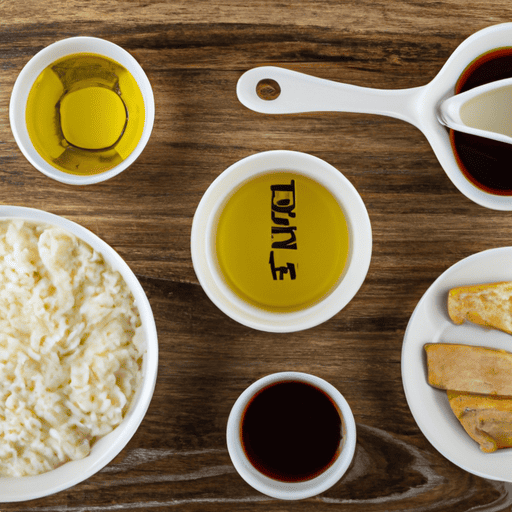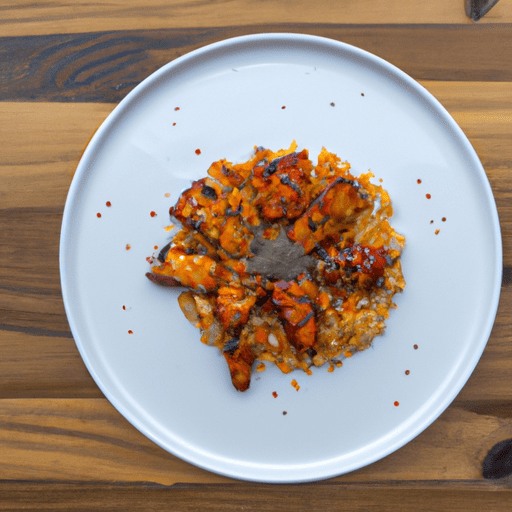Hello and welcome to Rice Cookers 101! Today we have a delicious and easy-to-make recipe for Korean Mahi-Mahi Rice. This recipe features the delicate and flavorful Mahi-Mahi fish alongside fragrant jasmine rice, vegetables, and delicious Korean spices. It is the perfect meal for both seafood lovers and those who enjoy a bit of spice in their dishes. With step-by-step instructions, you’ll be able to prepare this delicious dish in no time using your trusty rice cooker. Let’s get started! We’ve made this korean mahi-mahi rice recipe easy to follow 👨🍳. If you’re looking for our favorite rice cookers to make this recipe, check out our list of top rice cookers here.

Ingredients
- 1 cup of long-grain white rice
- 2 cups of water
- 1 tablespoon of vegetable oil
- 4 mahi-mahi fillets
- Salt and pepper to taste
- 1/2 cup of soy sauce
- 1/2 cup of brown sugar
- 1/4 cup of rice vinegar
- 1 tablespoon of toasted sesame oil
- 2 garlic cloves, minced
- 1 tablespoon of grated fresh ginger
- 1/4 cup of chopped green onions
Instructions
1. Rinse one cup of long-grain white rice in a fine mesh strainer and set it aside to drain.2. In a medium saucepan, bring two cups of water to a boil. Add the rice and stir to combine. Reduce the heat to low, cover the pan with a tight-fitting lid, and simmer for 18 to 20 minutes, or until the rice is tender and all the liquid has been absorbed.3. While the rice cooks, heat one tablespoon of vegetable oil in a large skillet over medium-high heat. Season four mahi-mahi fillets with salt and pepper and add them to the skillet. Cook for 3 to 5 minutes per side, or until the fish is cooked through and flakes easily with a fork.4. In a small saucepan over medium heat, whisk together one-half cup of soy sauce, one-half cup of brown sugar, one-quarter cup of rice vinegar, one tablespoon of toasted sesame oil, two minced garlic cloves, and one tablespoon of grated fresh ginger. Bring the mixture to a boil, then reduce the heat to low and simmer for 5 to 7 minutes, or until the sauce thickens slightly.5. Divide the cooked rice among four plates. Top each plate with a mahi-mahi fillet, and drizzle with the sauce. Garnish with a quarter cup of chopped green onions and serve immediately. 
How long does korean mahi-mahi rice last in the fridge?
Korean mahi-mahi rice can be stored in the fridge after cooking for up to 3-4 days if stored properly in an airtight container. It is important to note that the rice should be cooled down to room temperature before storing to prevent moisture buildup and bacterial growth. Additionally, it is recommended to reheat the rice thoroughly before consuming to ensure food safety. If you are unsure about the freshness of the rice or it appears to be spoiled, it is best to discard it to avoid any potential foodborne illnesses.
Low calorie korean mahi-mahi rice recipe substitutions
To make the Korean Mahi-Mahi Rice recipe lower in calories, some substitutions can be made. Firstly, instead of using long-grain white rice, brown rice or quinoa can be used to increase the fiber content and reduce the glycemic load. Secondly, to reduce the amount of oil used, cooking spray or non-stick pans can be used instead of vegetable oil. Thirdly, for the sauce, the amount of brown sugar can be reduced or replaced with a natural sweetener like stevia or honey in moderation. Lastly, the amount of soy sauce can be reduced or low-sodium soy sauce can be used to decrease the sodium content. With these small changes, the dish will still be flavorful and delicious while being lower in calories.
What to serve with a korean mahi-mahi rice?
There are several options to serve with Korean mahi-mahi rice, depending on your taste preferences. For a lighter option, consider a side salad with mixed greens, cucumber, and a tangy vinaigrette. If you prefer something heartier, roasted or grilled vegetables such as asparagus and bell peppers make a flavorful side dish. You can also add a couple of Korean side dishes like spicy kimchi, sweet and sour pickled radish, and savory bean sprouts on the side for some added texture and flavor. To complement the dish, serve a refreshing drink such as a light white wine or a Korean rice wine.
Whats the best sauce for a korean mahi-mahi rice?
The perfect sauce for Korean mahi-mahi rice is a blend of spicy and savory flavors, like gochujang sauce. Known for its signature red color and distinct taste, this fermented chili paste pairs perfectly with fish, adding depth and heat to the dish. Mix gochujang sauce with other ingredients like soy sauce, rice vinegar, honey, garlic, and ginger, and serve it atop your mahi-mahi rice for a delicious and authentic Korean flavor experience. Another option could be ssamjang, a dipping sauce made with fermented soybeans, chili paste, and sesame oil, which also complements fish and rice dishes beautifully.
Korean mahi-mahi rice health benefits
Korean mahi-mahi rice is a delicious dish that provides several health benefits. Mahi-mahi is a lean source of protein and is rich in omega-3 fatty acids, which are beneficial for heart health. The brown rice used in the dish is a whole grain that is high in fiber, which helps to promote digestive health and may also reduce the risk of heart disease and diabetes. Additionally, the dish contains a variety of vegetables such as carrots, bell peppers, and onions, which are nutrient-dense and provide vitamins and minerals such as vitamin C, vitamin A, and potassium. Overall, Korean mahi-mahi rice is a healthy and delicious meal. However, if you are looking for a dish that is even healthier, consider making a quinoa salad loaded with vegetables and lean protein such as grilled chicken or tofu. Quinoa is a complete protein and also provides fiber, vitamins, and minerals.

